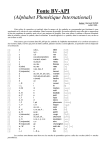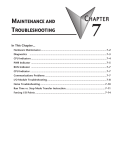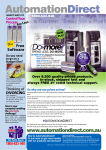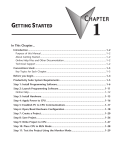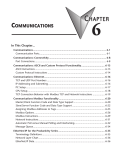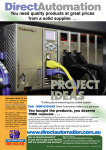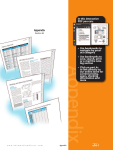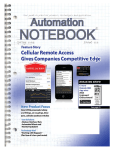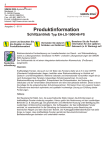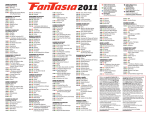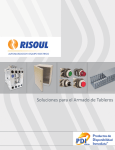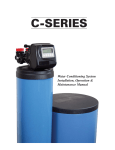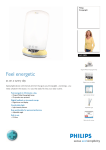Download Automation Notebook Fall 2015
Transcript
It’s time you get more than you paid for in a PLC. Introducing the NEW Affordable Innovation It’s not just the low price, but the incredible built-in features that make our new Productivity2000 a must-have controller. Why pay thousands elsewhere for features that are standard for our newest PLC, including FREE programming software? •5 built-in communications ports right on the CPU – All the communication you need is built right in! Modbus TCP/IP, EtherNet/IP, and serial devices are supported with no additional modules required! •OLED real-time data displays – View accurate process variable data (current, voltage and temperature) as well as system diagnostics on the Productivity2000 hardware OLED displays. No meter required! Plus – •Effortless PID loops •Flexible tag name programming •Auto-discovered I/O •Hot-swappable modules •Simple VFD configuration •Built-in data logging •Multiple wiring options •Web server functionality •Small footprint: 7-slot rack only 10-1/2” wide And with 50MB of user memory, USB plug-and-play programming functionality and a super low cost of ownership, the new Productivity2000 is the one you need! Order Today, Ships Today! * See our Web site for details and restrictions. © Copyright 2015 AutomationDirect, Cumming, GA USA. All rights reserved. AutomationDirect CPU and I/O Comparison Productivity2000 Allen-Bradley CompactLogix Base (if required) $69.00 P2-04B N/A N/A Power Supply $69.00 P2-01AC 1769-PA4 CPU $255.00 P2-550 $3,160.00 1769-L33ER 16 AC Inputs $105.00 P2-16NA 1769-IA16 16 24VDC Inputs $69.00 P2-16NE3 1769-IQ16 8 Relay Outputs $51.00 P2-08TRS 1769-OW8I 8 Analog Input Channels (mA) $199.00 P2-08AD-1 1769-IF8 ASCII Comm Module $0.00 Built in to CPU 1769-ASCII Modbus RTU Comm Module $0.00 Built in to CPU 1769-SM2 Total System Price with USB, Ethernet and Serial $817.00 $6557.50 $414.50 $286.00 $244.00 $301.50 $713.50 $737.00 $701.00 All prices are U.S. published prices. AutomationDirect prices as of 6/5/2015. Allen-Bradley retail prices taken from www.plccenter.com 5/12/2015. Get more than you paid for . . . www.Productivity2000.com 1-800-633-0405 the #1 value in automation Automation Notebook • Fall 2015, Issue Thirty-three Your guide to practical products, technologies and applications Contributors Editor’s Note Publisher Tina Gable Managing Editor Joan Welty Coordinating Editor Design Manager Contributing Writers TJ Johns Justin Stegall Cindy Green Peter James Chip McDaniel Jeff Payne Contacts Automationdirect.com Inc. 3505 Hutchinson Road Cumming, GA 30040 Phone.......................1-800-633-0405 or 1-770-889-2858 Fax...........................1-770-889-7876 Monday - Friday 9:00 a.m. to 6:00 p.m. EST www.automationdirect.com Copyright 2015, Automationdirect.com Incorporated/ All Rights Reserved. No part of this publication shall be copied, reproduced, or transmitted in any way without the prior, written consent of Automationdirect.com Incorporated. Automationdirect retains the exclusive rights to all information included in this document. If you are a non-subscriber and would like to be included in the next mailing of AutomationNotebook, please visit: http://library. automationdirect.com/ information-should-be-free/ and complete the details. You can also request FREE stuff, including our catalog and our CD-ROM featuring the entire catalog and demo software. If you provide your email address, we will send news and product information from time to time as well. For those who prefer to speak with us in person, please call 1-800-633-0405 x1845. Thanks for your interest, and we look forward to hearing from you. That’s not a good idea. Recently, while traveling along the Georgia coast, my wife and I happened upon Memory Park Christ Chapel. With signage calling it “The Smallest Church in America”, Agnes Harper constructed the 10 x 15-foot structure back in 1949. This quaint chapel is nestled in a small forest of Spanish moss-covered Live Oaks to provide a place of rest and inspiration for weary travelers. Naysayers said it was foolishness and a waste of funds on such a small structure. Maintaining it was the thought that mattered and not the scope, she ignored the skeptics and built anyway. Some 66 years later, people from across the nation continue to stop by to rest, reflect and recharge. When AutomationDirect began way back in 1993, people said the business model would never work. But with determination and proper focus, we continue to provide the quality products and award-winning customer support our customers expect. We have a lot of great material crammed in this issue of NOTEBOOK. In addition to information about new products, our cover story explains how machine builders and their customers benefit from connecting machines to IT systems. Our User Solution story explains how adding a variable frequency drive improved a mill/drill machine and our Student Spotlight section is a double feature. First, students at Penn State have been working on a Baobab pulp processor in conjunction with the residents of villages in Benin, Malawi, South Africa, and also in Madagascar. The second spotlight story discusses how Scott Shier exposes a group of fifteen ‘Home Haunter’ students to the capabilities of pneumatic systems often used in haunted houses. We have all this and more. As always, stop by the ever-popular Break Room for our brainteasers and then compare your answers at www.automationnotebook.com Table of Contents New Product Focus 4 Product Snapshots 6 Cover Story 8 Business Notes 12 Tech Brief 16 Student Spotlight 20 User Solutions 22 Student Spotlight 26 Break Room 31 AutomationDirect Unveils Productivity®2000 Programmable Controller • Access Control Barriers • UL 489 Rated Miniature Circuit Breakers and UL 1077 Rated Supplementary Protectors • Harsh Duty/Food and Beverage Quick Disconnect Cables • Harsh-Duty Photoelectric sensors • High-Performance 48VDC Drives • ProSense® Flow Transmitters with 4-20mA Output • Liquid-Tight Conduit Connectors • New Stellar® Full-Featured 3-Phase Soft Starters • E-Stop Control Stations with Maintenance Lockout Feature Linking Machines to IT Systems Take a look at our NEWEST collection of videos: Automation Cookbook. Productivity2000 Features and FAQs ® Pulp Processor Speeds Production of Healthy Supplement Converting a Mill/Drill and installing a VFD Shier Terror Haunts West Coast BrainTeasers TJ Johns Coordinating Editor [email protected] www.automationnotebook.com 3 New Product Focus AUTOMATIONDIRECT UNVEILS PRODUCTIVITY®2000 PROGRAMMABLE CONTROLLER T he Pr o d u c t i v i t y 2 0 0 0 is AutomationDirect’s newest addition to the Productivity line of industrial controllers. The Productivity2000 is a modular, rack-based system with a full lineup of discrete, analog and specialty I/O modules. The high-performance CPU has 50Mb of user memory, fast scan times and five communication ports for $255. The P2-550 CPU features a 4 line x 10 character high-resolution OLED diagnostic text display with keypad for status, configuration, system alarms and user-defined messages, as well as LED status indicators. Five onboard communications ports, including Ethernet, USB and serial, support communications protocols including EtherNet/IP®, Modbus TCP and ASCII. A micro USB 2.0 (type B) port provides plug-and-play connection for programming, online monitoring and firmware upgrades. One RS232 and one RS485 serial port can communicate via Modbus or ASCII protocols for local networking or custom device interfaces. The bottom of the CPU is fitted with two 10/100 Mbps Ethernet ports; the first port is used for programming, monitoring, and firmware upgrades as well as client/server connections (Modbus TCP, EtherNet/IP scanner and adapters). A second Ethernet port is dedicated for up to 16 GS1, GS2 or DURApulse variable frequency drive connections. A microSD card slot accepts a standard microSD card to provide up to 32GB of data logging capacity. This card can also be used to transfer projects to and from the CPU. The CPU’s built-in Web server allows users to view, download and delete data log files from any browser. The P2-01AC ($69) power supply provides isolated power to the P2000 system; I/O bases, starting at $69.00, are available in 4, 7, 11, and 15-slot models; any combination of I/O modules may be installed in a base without power budget considerations. Over 25 I/O modules capture and control a wide range 4 of field signals, including up to 16-point DC I/O, 16-point AC I/O, and analog voltage, current or temperature. The OLED interface built into each analog module displays field signal levels as well as module and signal faults. Hot swappable I/O support allows exchange of modules without interrupting the process. Each I/O module includes a pull-down QR coded tab which can be scanned from any smart phone or tablet to get the latest specifications for that module. With the P2-SCM serial communications module ($165), the Productivity2000 system can have up to 46 serial ports. The module features three RS-232 ports and one RS-485 port utilizing Modbus RTU Master/Slave networking, ASCII IN/OUT and custom protocols; port one can also be used to power a C-more micro HMI. Available specialty modules include two high-speed 2-channel counter input and pulse output modules ($195) as well as an 8-point input simulator module with eight hand operated switches ($47); a filler module ($11) for unused slot connections is also available. The updated free downloadable ProductivitySuite programming software features tag name based programming for added programming versatility, better documentation management and more seamless integration with HMIs. Productivity2000 gives users the freedom to define user tags with no limits or fixed boundaries. With tag name based programming, there are no predefined, fixed memory maps and no wasted, unused memory allocations. The software can perform hardware auto-discovery and configuration, including local base and I/O and GS series AC drives. The user can also configure the system offline by dragging and dropping modules. After configuration is complete, modules can be electronically keyed to prevent incorrect replacement. Powerful processes in the programming environment reduce development time; time-savers include combined ladder logic and function block-style programming; task management that minimizes scan time; advanced instructions that simplify complex tasks, and an exhaustive HELP file that covers both hardware and software topics. The complete line of Productivity2000 components can be seen at: www.automationdirect.com/P2000 Now you can expect more from your HMI! MORE LOGIC The C-more EA9 HMI software (just $99) now delivers more functionality, usability and value to our popular C-more touch panels. Dozen of new features and upgrades give you MORE for LESS! • New tag combinations allow simple logic with multiple events • Combine up to four different tags to trigger actions based on logical results MORE MATH • New math functions let you create custom formulas with constants or tag values • The Math Keypad provides both simple and complex operations including log, sine, and square root MORE ACCESSIBILITY • The new Object Layer List Window shows all the objects on the active screen and lets you lock/unlock, hide/unhide objects or quickly select them for editing • The Object Layer List allows access to individual objects in a group; additional lists for hidden, locked or overlapping objects • Recipe database supports 99 recipe sheets, each with 1000 recipes of 256 possible tags or values; operator can now modify and save while the process is active • New menu options, customizable toolbars and updated graphics for improved ease of use MORE ALARMING OPTIONS • Enhanced Alarm List offers more options for alarm customization • New alarm filters allow for dedicated alarm summaries C-more EA9 Touch Panels start at $499! C-more EA9 Software EA9-T12CL 12” model shown priced at $1790 MORE DRIVERS • C-more panels have drivers for most major brands of PLCs. See the entire list at www.automationdirect.com/c-more-drivers LESS COST • With software at $99 and hardware starting at just $499, C-more gives you one of the best costs of ownership, considering initial price, features, ease of use, reliability and free award-winning technical support $99 EA9-PGMSW C-more Remote HMI App For only $4.99 you can have remote access and control on the go! Available now in your Apple® or AndroidTM app store. Get more than you paid for . . . C-more.AutomationDirect.com * EA9-PGMSW for use with EA9 series panels only; cannot be used with EA7 series panels. Order Today, Ships Today! * See our Web site for details and restrictions. © Copyright 2015 AutomationDirect, Cumming, GA USA. All rights reserved. 1-800-633-0405 the #1 value in automation Product Snapshots RECENTLY ADDED PRODUCTS ACCESS CONTROL BARRIERS HARSH DUTY/FOOD AND BEVERAGE QUICK DISCONNECT CABLES have a selectable light-on/dark-on output setting; sensing ranges are available up to 10m. Backed by a one-year warranty, FM series photoelectric sensors are cULus, CE and RoHS approved. www.automationdirect.com/ photoelectric HIGH-PERFORMANCE 48VDC DRIVES NOW AVAILABLE Contrinex YCA 50-series safety light curtains have configurable operating distances of 1-15 and 10-50 meters and protective heights to 1,232 mm. Safety light curtains have Type 4 and Cat 4 PLe safety ratings and are IP65 and IP67 rated. Light curtain components start at $350. Starting at $640, YXC-series light curtain mirror columns provide multi-sided safeguarding of danger zones. Access control barriers and accessories are cULus, CE and RoHS compliant. Ideal for food and beverage washdown applications, these IP69K-rated sensor cables have industry-standard M8 connectors with open leads or with quick disconnect plugs on each end (patch cables). Cable lengths range from 0.6 to 10 meters. Cables are UL Listed (US and Canada) and have a 1-year warranty. M8 IP69K-rated Q/D sensor cables start at $10 and M8 IP69K-rated patch cables start at $15. www.automationdirect.com/ light-curtains www.automationdirect.com/ cables UL 489 RATED MINIATURE CIRCUIT BREAKERS AND UL 1077 RATED SUPPLEMENTARY PROTECTORS HARSH-DUTY PHOTOELECTRIC SENSORS IronHorse® GSD1 series DC drives are high-performance Pulse-Width-Modulated (PWM) controllers for 12 to 48 volt equipment providing smooth control with high-efficiency operation. GSD1 series drives are available in 10A (1/8 to 1/2 HP motor rating) and 20A (1/4 to 1 HP motor rating) versions. New models allow jumper selectable 12, 24, 36 or 48V operating voltage. Starting at $115, GSD1 series DC drives are available in open-frame and NEMA 4X enclosed styles, and all come standard with a speed pot, knob, and dial plate. GSD1 series DC drives are RoHS compliant and are backed with a one-year warranty. www.automationdirect.com/ dc-drives Eaton FAZ-NA Series UL 489 DINrail mountable mini circuit breakers are available in single, two and three-pole models. FAZ series UL 1077 supplementary protector breakers provide overcurrent protection where branch protection is not required. These protectors are available in single, double and triple pole models. UL 489 mini circuit breakers start at $18 and UL 1077 rated supplementary protectors at $9. www.automationdirect.com/ circuit-protection 6 The new FM series harsh duty photoelectric sensors are IP69K-rated sensors in three-wire NPN or PNP styles and are available in 27 washdown models. Ideal for food and beverage applications, the 10-30 VDC rectangular sensors are fitted with 316L stainless steel housings and are available in diffuse, diffuse with background suppression and polarized retroreflective styles starting at $42.00; through-beam models are sold as an emitter (starting at $33.00) and receiver (starting at $40) separately. The harsh-duty photoelectric sensors have either an attached two-meter output cable, or an M8 or M12 quick-disconnect. All models Automation Notebook • Fall 2015, Issue Thirty-three PROSENSE® FLOW TRANSMITTERS WITH 4-20MA OUTPUT steel heavy-duty locknut to assure continuity of ground; a patented split gland-ring slips onto the conduit quickly to grip the jacket of the conduit, assuring a perfect seal, and preventing pullouts. E-STOP CONTROL STATIONS WITH MAINTENANCE LOCKOUT FEATURE www.automationdirect.com/ conduit-connectors NEW STELLAR® FULL-FEATURED 3-PHASE SOFT STARTERS New FSA series flow transmitters provide a 4-20mA analog output proportional to liquid media flow rate. Available in three flow ranges up to 27GPM, the transmitters have a M12 quick disconnect and 3/4inch or 1-inch FNPT process connections. The integrated check valve design allows the sensor to be mounted vertically or horizontally. Starting at $140, FM Series flow transmitters are IP65 and IP67 rated and cULus, CE and ROHS compliant. www.automationdirect.com/ flow-sensor LIQUID-TIGHT CONDUIT CONNECTORS IDEM emergency stop control stations are available with button protection shrouds that accept a padlock for safe maintenance lockout. Stations are available in IP67rated plastic (starting at $29) or IP69Krated (NEMA 6) stainless steel housings (from $125); and are ISO, cULus and CE compliant. SR55 series three-phase AC motor soft starters are available in three frame sizes with 24VDC, 110 or 230 VAC selectable control voltages and are designed for 17 to 477 full-load amps (at 200-480 VAC). SR55 soft starters provide full motor overload protection and built-in SCR failure protection. The units include a touchscreen for application set up and monitoring, programmable analog and digital I/O, integrated Modbus RTU and optional Modbus TCP or EtherNet/IP communications. Starting at $975, the SR55 series soft starters are UL listed, CE, REACH, and RoHS approved. www.automationdirect.com/ pushbuttons www.automationdirect.com/ soft-starters RACO liquid-tight connectors, in 3/8inch to 2-inch thread sizes and insulated or uninsulated styles, are designed for use on flexible metallic liquid-tight conduit and Type B flexible non-metallic liquid-tight conduit in outdoor or indoor locations. Starting at $1.75, connectors are available in straight and 90-degree models. Liquid-tight connectors are used to positively bond the conduit to a box or enclosure; the connectors are suitable for use in Class I, Div 2; Class II, Div 1 & 2; and Class III, Div 1 & 2 hazardous locations. All models feature a zinc-plated www.automationnotebook.com 7 Cover Story LINKING MACHINES TO IT SYSTEMS By Cindy Green, AutomationDirect O nce upon a time, individual machines were stranded on an island, or just linked to other machines using a few discrete I/O and dry contact relays. Then came machine-to-machine data links such as a proprietary PLC-based network. Today, and certainly in the future, machines are being linked to IT systems. Both machine builders and their customers benefit from connecting machines to IT systems. The closed systems and proprietary communication protocols of the past, and the difficulties they caused, have given way to open systems. This makes it easier to get connected, as today’s standard communication protocols and open systems are providing a clear path to integration. In the Control Design July 2015 Cover story “Tear Down This Wall!”, Doug Putnam-Pite says, “Linking our tools and machines to IT systems allows our customers to customize data acquisition systems to meet their specific needs, monitor machine performance remotely and compare performance among multiple machines.” PutnamPite is director of software development at Owens Design (www.owensdesign.com) in Fremont, California. Owens Design makes high-speed material handling equipment for the semiconductor, disk drive, consumer electronics and solar industries (Figure 1). “Linking machines to IT systems provides a great deal of information about how and where to deploy idle machines, along with information about when it is safe to continue, or when there is a need to stop a machine or process,” points out Richard Clark, Wonderware InduSoft technical Plus – specialist at Schneider Electric (www.schneider-electric.com) in the • Effortless PID loops • Flexible name article. “Thistaginformation can be used to programming increase uptime, reduce operating costs, • Auto-discovered I/O and •provide the ability to make decisions Hot-swappable modules remotely. Interfacing with ERP, and using JIT • Simple VFD configuration • Built-in data logging or other ordering or supply chain techniques, • Multiple wiring machine options can help match production to • Web server functionality process line needs.” • Small footprint: 7-slot Improved product quality is a rack only 10-1/2” wide never-ending goal of most production machines and systems. Collecting data from machines and sending it to quality FIGURE 1: This 300mm wafer platform is made by Owens Design and is connected to their customer’s IT system via a PC and OPC. (Image courtesy of Owens Design). 8 continued p. 10 >> Amazing features... Amazing price! STELLAR NEW! SR55 Series full-featured AC motor soft starters Reduce shock and stress on your motor and your wallet with the new SR55 series soft starters. The SR55 is fully digital, fully programmable and is packed full of amazing features including: • • • • • • • • Full three-phase motor control with thyristors in all three motor phases Built-in internal bypass relays and patented iERS (intelligent Energy Recovery System) that reduces energy costs when used on lightly loaded and oversized motors Full data logging (fault records, motor current, operational status, etc.) Integrated Modbus RTU, or optional Modbus TCP or EtherNet/IP communication Touchscreen with easy-to-navigate menu structure; includes the Automatic Application Setup feature that fully configures the starter for a specific application with one entry Programmable analog I/O, digital inputs, and relay outputs for remote control Built-in SCR failure protection and full motor overload protection Two-year warranty Order Today, Ships Today! * See our Web site for details and restrictions. © Copyright 2015 AutomationDirect, Cumming, GA USA. All rights reserved. ® soft starters Starting at $975.00, SR55 soft starters are available in three frames sizes with a rated current up to 477A. • • • • • Frame size 1: 17A - 96A / 200VAC - 480VAC Frame size 2: 124A - 180A / 200VAC - 480VAC Frame size 3: 242A - 477A / 200VAC - 480VAC 24VDC, 110VAC, or 230VAC selectable control voltage Suitable for a wide variety of motor loads and can be connected ‘in-the-delta’, allowing use of a smaller soft starter Get more than you paid for . . . www.automationdirect.com/soft-starters 1-800-633-0405 the #1 value in automation Cover Story continued continued from p. 8 assurance and quality control software for press, an RFID system tracks the cylinders. This has eliminated cylinders being lost due monitoring and analysis helps achieve this to operator error, incorrect cylinders being goal. Connecting machines to IT or ERP systems allows real time inventory control. It engraved or wrong jobs being loaded into the engravers,” continues Gilson in also allows remote access by OEMs and their customers. These remote access features the article. often use cloud-based connections to the “The data from the RFID readers also IT system (Table 1). tracks the cylinder carts to make sure the 1.Optimize operation of each machine 2. Coordinate operation among machines 3. Production planning 4. Inventory control 5.Quality analysis and control 6. Remote access Reasons to Link Machines to IT Systems TABLE 1: Reasons to Link Machines to IT Systems Table reprinted from Control Design July 2015 Cover story “Tear Down This Wall! Open Communication Between the Plant Floor and the IT Network” cylinders are placed on the correct carts for transport,” says Gilson. “This prevents accidents when cylinders are misplaced on carts. The control system reads the status of the equipment to track the cylinder movement, loads the correct job into the engravers, controls inventory and ensures the correct cylinders are brought out to both the imaging department and the printing presses.” According to the Cover Story, Quad/ Graphics’ inventory control system starts with RFID scanners from Turck (www.turck.com), which they use to scan print cylinders with Turck RFID tags (Figure 2). These scanners are connected to a PLC-based Horstmann Cylinder Storage and Retrieval system. Quad/Graphics’ automation controls system (ACS) uses OPC to read status bits from the PLCs, and to write commands to the PLCs. The commands can be to pick/place cylinders, reset faults, abort task and retrieve/store cylinders. The ACS is a custom IT application running on a server. Users install and run a client application on their laptop or PC to interface to the ACS. Open communication hardware and software standards make it easier to create and maintain links between machines and IT systems. This is particularly true with PC-based controls and HMIs. OPC Simplifies Integration OEMs providing machines with PC-based HMIs, such as Owens Design, often link to IT systems using Open Platform Communication (OPC). The PC makes it easy, but others prefer connecting the IT system directly to the PLC. Duane Gilson, a control engineer at Quad/Graphics (www.quadgraphics.com), located in Sussex, Wisconsin, employs PLCs to track cylinders in an inventory control system for printing machines and other similar processes. “The automation of our cylinder storage and retrieval system in Franklin, Kentucky, was instrumental in reducing processing time, increasing throughput, eliminating errors and improving safety,” notes Gilson in the cover story. “From the time an operator inbounds a cylinder into the storage system until it is processed and sent back to the printing 10 FIGURE 2: Quad Graphics uses a handheld scanner to read data from an RFID tag affixed to print cylinders, allowing inventory tracking. (Image courtesy of TURCK). Automation Notebook • Fall 2015, Issue Thirty-three FIGURE 3: STIWA sends production data from its machine controllers to IT systems for analysis, optimizing operation (Image courtesy of STIWA) Enabling data analysis STIWA Automation (www.stiwa.com/ en/home) uses PLCs to communicate directly to IT systems. In its assembly and process modules (Figure 3), and in its automated transport, feeding and packaging systems, it uses its manufacturing software to collect data directly from PLCs. The manufacturing software allows STIWA engineers to use MatLab (www.matlab.com) to analyze the large amounts of production data collected. This capability increases output by enabling reductions in cycle times through the calculation of time-optimal trajectories for the modules. Every second, STIWA’s system collects over one megabyte of raw production data including torque, noise and a variety of other module measurements. The data is filtered, processed and analyzed using a variety of algorithms to establish suitable tolerances, modify production process variables or compute time-optimized motion tracks for robots and other transfer systems. These algorithms were originally written in structured text within the PLC. As the algorithms became more complex, this method was found to be slow. With the connection to the IT system, STIWA engineers can import machine and product data into MatLab to visualize the data and to identify problems and optimization opportunities. In the Control Design article, Martin Werner states, “To be effective, our algorithms must analyze a huge amount of data in near real-time.” Werner is a software tools development engineer at STIWA. “We www.automationnotebook.com achieved this high level of performance by optimizing our MatLab algorithms.” For decades, many options have been available for machine builders to implement remote access, but improvements are providing faster implementation, improved security and wider access. 11 Business Notes TAKE A LOOK AT OUR NEWEST COLLECTION OF VIDEOS: AUTOMATION COOKBOOK A utomation Cookbook is a collection of short video chapters covering a wide variety of automation application topics. Each chapter starts with a “U can do it!” overview, which explains the capabilities and usefulness of a specific automation task. There is a group of “Tech Tips” videos in each chapter, where we detail technical nuggets and the “gotchas” that can slow down experts and novices alike when specifying and implementing the topic in question. Here’s the best part: we have “How To” videos that show step-by-step demonstrations of exactly how to hook up, troubleshoot, and even program the task at hand. The Cookbook currently includes chapters on Temperature Sensing, Object Detection, A/C Motors (On/Off Control), Distance Measuring and SCADA/HMI, but check back often for many other automation topics. You can navigate directly to: www.automationdirect.com/ videos/cookbook The Automation Cookbook is also easily accessible from any page on the AutomationDirect main Web site: Simply click the link “Video Tutorials” located on the left-hand navigation bar (marked 1 in the image to the right). The Video Home page will be displayed, where you can click on the Tab labeled “Automation Cookbook” (2). The image to the right also illustrates the layout for each chapter of the cookbook. The “U can do it” video is at the top, continued p. 14 >> 12 www.automationdirect.com/videos/cookbook Protect your plant and your budget... with control stations from AutomationDirect! Emergency Stop Control Stations IDEM E-Stop control stations provide robust emergency stop protection for exposed conveyors, machinery, etc. LED and protection guard options are available and both the ES and ESL series feature a lid safety trip mechanism for added safety. • 3- or 4-pole positive guided contacts • Operational rating: 240VAC 3A / 120VAC 6A • Plastic housings (IP67) or stainless steel 316 housings (IP69K) • Conformance to ISO 13850, IEC 60947-5-1 and IEC 60947-5-5 • 40mm twist-to-release mushroom head operator • Lid safety trip mechanism ensures the safety contacts will open if the lid is removed • Optional E-Stop lock off protection guard accepts a padlock to lock out equipment for maintenance activities Starting at: $29.00 (ES-P-230001) Hazardous Location Control Stations Killark control stations are designed to contain and extinguish explosions, making them ideal for installations in refineries, chemical and other processing facilities where flammable materials are present. KILLARK FXCS Series Factory Sealed KILLARK XCS Series Unsealed • Eliminates external sealing requirements • External sealing required • NEMA 3 weatherproof • Cast conduit hubs (1/2”, 3/4” and 1”), either dead end or feed through, standard in both single and two-gang assemblies Starting at: $88.75 (XCS-0B1) • Miniature and standard size pushbuttons • Device bodies and covers are cast copper-free aluminum alloy in a wide assortment for custom assemblies • Pushbutton, selector switches and pilot light bodies are copper-free aluminum • Operating shaft in both pushbuttons and selector switches are stainless steel Research, price, and buy at: www.automationdirect.com/pushbuttons Also Available Stacklights Visual Signal Devices Order Today, Ships Today! * See our Web site for details and restrictions. © Copyright 2014 AutomationDirect, Cumming, GA USA. All rights reserved. Audible Horns Pushbuttons, Pilot Lights and Switches 1-800-633-0405 Wire and Cable the #1 value in automation Business Notes continued continued from p. 12 followed by numerous helpful “Tech Tips” videos, and then the hardware-specific “How to” videos that can get you up and running in minutes. So what can you expect in each topic? sense presence using light beams. Learn about each type of sensing technology and its suitable application spaces; see typical ladder logic programming for detecting objects with CLICK, Do-more and Productivity series PLCs. Temperature Sensing A/C Motors (On/Off Control) From curing ovens to milk pasteurization, temperature sensing and control has become an important part of automation. Learn about types of temperature sensors and how they work; hardware review of temperature probe and transmitter styles; how to select the right temperature sensor for your application; see typical ladder logic programming for temperature sensing with CLICK, Do-more and Productivity series PLCs. Most control systems have to make things move, and that usually involves motors. Learn about AC motor control, from a simple switch to full reversing contactor configurations; selecting and using contactors and associated circuit breakers, overload protectors, and surge protectors; see typical hardware components and ladder logic programming for motor control with CLICK, Do-more and Productivity series PLCs. Object Detection One of the most pervasive functions of a control system is detecting the presence of an object. There are a myriad of sensing technologies, such as inductive, capacitive and ultrasonic devices that detect nearness (proximity), and photoelectric devices that 14 Distance Measuring A more advanced object detection function involves measuring the actual distance of an object from the sensing point. Learn about distance measuring technologies including ultrasonic and laser sensors; selecting the correct measuring style depending on the environment and object types; how to set up and use distance sensors; see typical ladder logic programming for distance measuring with CLICK, Do-more and Productivity series PLCs. Got ideas for a Cookbook topic? Drop us a note: [email protected] and put “Automation Cookbook Idea” in your subject line. New, lower prices on LED message displays! Now starting at: $435.00 (MD4-0112T) 12 characters/1 line Six models to choose from: NEW PRICES $435 $613 Unit shown $916 .00 $916 (MD4-0412T) 12 characters/4 line $599 Industrial LED message displays keep your plant personnel in the know $929 $1,551 Our low-priced ViewMarq LED message boards can display preformatted and real-time factory floor data messages sent by a PLC, PC, or other master device. The text message displays can be controlled by: • ASCII strings through the RS232 or RS485 port • Modbus RTU messsages through the RS232 or RS485 port • Modbus TCP messages through the Ethernet port ® Use the FREE Viewmarq configuration software (online download) to configure the display; create, preview and send messages from a PC; or create ASCII strings that can be transferred to PLC instructions to control the Viewmarq. Wall mount brackets for easy mounting The Viewmarq line offers: • One-, two-, and four-line displays • Viewing distances up to 400 feet and 140 degree viewing angle • (1) RS232, (1) RS485 and (1) Ethernet port standard on all models • NEMA 4 / NEMA 12 extruded aluminum housings suitable for harsh environments • Chain and wall/ceiling mount brackets included Connect to PLCs or other compatible master devices C-more Micro touch panels C-more touch panels Also Available Research, price, buy at: www.automationdirect.com/viewmarq Order Today, Ships Today! * See our Web site for details and restrictions. © Copyright 2014 AutomationDirect, Cumming, GA USA. All rights reserved. 1-800-633-0405 the #1 value in automation Tech Brief PRODUCTIVITY 2000 FEATURES & FAQS ® By Jeff Payne, Automation Controls Product Manager, AutomationDirect I t’s not just the low price, but the incredible built-in features that make our new Productivity2000 a must-have controller. The newest programmable logic controller from AutomationDirect, the Productivity2000 (P2000), is built around a compact modular form factor that allows both fit and functionality in a small space. In this introduction we will discuss key features and answer some frequently asked questions about this mighty-mite control system. From the built-in capabilities of the CPU, the documentation at your fingertips with the QR codes, to the ultra-clear OLED displays that give you more than just module status, the features are numerous. Let’s Talk Price Let’s face it, when you’re working within a budget you have to make difficult decisions. Sacrificing quality is not an option, and your time is more valuable than most any line item on your BOM. With AutomationDirect products, our customers typically pay a fraction of the cost when compared to our major competitors. And with Productivity2000, you can rest assured that you have installed a high quality control system to increase productivity, saving time and money. When comparing basic hardware the savings are obvious; however, the real savings are in the recurring costs you save when compared to those levied by most of the major suppliers in our market. Some of these include: • Software costs • License fees per PC • Annual service contract • Access to online resources (forums, firmware downloads, etc.) When shopping for a control solution, you need hardware and software; you don’t need overhead and recurring costs. Choosing the Productivity2000 is choosing the lowest total cost of ownership: 16 • Low initial hardware cost • Free shipping • Free programming software • Free software/firmware upgrades • Free technical support And as always, we provide up front pricing with no strings attached. Our feature-packed P2-550 CPU is priced at $255 and I/O modules start at just $40 (P2-08NE3). What about Communications? One of the staples in the Productivity Series is the CPU’s built-in communications capabilities. Ethernet, serial, and USB ports, along with the protocols needed for connectivity, are available as standard features on this CPU. No need to pay extra for Ethernet and USB ports; no need to add modules to your base which consume valuable I/O slots. And, there is no need to pay extra for the industry’s leading Ethernet protocol, EtherNet/IP. This powerful controller definitely gives you “More bang for the buck”. The CPU module includes: • (2) Ethernet ports that support EtherNet/IP, Modbus TCP, GSDrives (auto-discover), Email, FTP, programming and troubleshooting • (2) Serial ports, (1) RS-232 and (1) RS-485, that support Modbus RTU, ASCII and even ‘Custom Protocols’ you define within ladder logic • (1) Plug-n-Play USB programming and monitoring port High resolution 4 line by 10 character OLED diagnostic display Removable micro SD slot 50MB of built-in memory Up to 32 Gb of data storage per card USB RS-232 RS-485 LED status indicators Three communications protocols 10/100 Ethernet Multipurpose 10/100 Ethernet Remote I/O Modbus® GS drives only Automation Notebook • Fall 2015, Issue Thirty-three In addition to the vast communications capabilities, there is a microSD card slot for data logging and project transfer, and a high clarity Organic Light Emitting Diode (OLED) display for diagnostics and simple message display. What about Programming? www.Productivity2000.com The ProductivitySuite programming software is designed for flexibility and customization. Organize the layout in a way that best satisfies your programming style and preferences. Easily auto-discover your system I/O and connected GS Drives in the system’s hardware configuration. Use the tag database import/export to manage your tags names, or for use with peripheral devices such as OIP, HMI and SCADA packages. Data View gives you three separate ways to view your process or machine data. 1.) The simple data view is a table view where you add the tags of your choice, view the current data, edit or force the data and monitor the Modbus address. 2.) Graph view lets you drag any tag from the table view and begin plotting those data points on a line graph. 3.) I/O view offers a unique graphical look at your current physical I/O modules and their data. Time for Q & A Does the Productivity2000 support highspeed I/O modules? Yes, we have both a high speed input (P2-HSI), supporting 2 channels up to 1MHz/ each, and a high speed output (P2-HSO) also with 2 channels up to 1MHz/each. Both modules sell for $195 and both have additional general purpose I/O. Can I collect data with the P2-550? Yes. The P2-550 CPU has a microSD card slot built in, so recording data from process values is as easy as adding a tag to a list and selecting the frequency at which you would like it to be recorded, or define the event that you would like to trigger the process. What are the benefits of the OLED displays? The display on the CPU will show critical and non-critical fault messages as well as custom messages configured in the ladder using the LCD instruction. The analog module displays provide process data and module status at your fingertips – a pricey feature from our competitors. We give you 4 or 8 channels of raw analog values (i.e. 0-10V or 4-20mA), converted digital values (i.e. 0-65535) and even actual temperature in deg F or deg C. How is TAG NAME programming different from a “typical” PLC? There are two basic types of memory addressing in PLCs today: Fixed addressed memory and Tag name database memory. www.automationnotebook.com First, I would point out that the majority of all controllers designed in the past 15 years are tag name based controllers. Since PLCs are designed to be installed and operate for decades without being replaced, sometimes progress moves slowly. Let’s look at how both types function and consider some benefits of Tag based programming. 1.) Memory allocation - Fixed address controllers have a set amount of memory allocated for each data type, i.e., 16,000 In, 16,000 Out, 4095 integers, 4095 floats, 512 timers, 256 counters, etc. The down side is they’re not adjustable and if you run out of a particular data type, you have no additional options. - Tag based addressing is more dynamic. You assign data types as you create your tag names. You have a maximum amount of memory allocated for that data and it is free form, meaning that you can create as many or as few different data types as you need to suit your application. 2.) Descriptive naming - In fixed address controllers you have entities represented by letters and numbers. i.e. X1 for an input, O0:4/13 for an output, C200 for an internal control bit or N7:32 for a 16-bit integer entity. These are easy enough to work with, once you learn them, but they mean absolutely nothing with regards to the real world devices they are connected to and controlling. - In Tag based addressing you name the memory location, i.e., SYSTEM_ START for an Input, EXHAST_FAN_ON continued p. 18>> 17 Tech Brief continued contingud from p.17 for an output, PURGE_TIMER for a all Productivity2000 I/O modules, timer, QA_REJECT for a counter, you have instant online access AUTO_MODE for a control bit and to module spec data and DWELL_TMR.PRE for an integer. wiring diagrams. The key benefit is that the programmer is Are there plans for remote forced into following preferred programming expansion for Productivity2000? practices and adequately documenting his/ Yes. We will be offering her project. With the Productivity Series multiple expansion options for the controllers, the tag name database is always Productivity2000 in the future. downloaded to the CPU with the project, so it Are the AutomationDirect is no longer necessary to have an up-to-date GS drives auto-discovered in copy of the project file on each computer. Productivity2000, like they are The user could connect to the PLC with a in the Productivity3000? new laptop and have access to 100% of the Yes. This is a feature that has documentation – a tremendous benefit when many benefits. troubleshooting a system. - Auto-discovery saves you time when Additionally, with each project we connecting the components together. save a .csv file of the tag database in the - Configuring VFD parameters from the project folder with the same name as the PLC software saves you time during project. This allows the user to easily import initial setup. However, you also get this file into C-more HMI software, Point of the added benefit of storing those View SCADA, KepOPC software, DataWorx parameters in the PLC project file. If Database software, etc. If you prefer, you can you have to replace a drive in the field, also manually edit the tag database in Excel. the current configuration is retained What aspects of the EtherNet/IP protocol in the project, and can be transferred are supported by Productivity2000? to the new drive, saving you even more - I/O Messaging (Class 1 implicit) valuable time when a machine - Class 3 Explicit Messaging (Connected) is down. - Unconnected Explicit Messaging - GSR (read) and GSW (write) instructions - Both Client and Adapter configurations are designed specifically for controlling are supported (separately or at the the GS Drives, making programming same time) and startup a snap. The P2-550 CPU is an ODVA certified - For additional information on using EtherNet/IP device. For additional information GS Drives with the Productivity Series on EtherNet/IP, please view our video series; controllers, please view our https://youtu.be/qqtmmN6pnzk video series; What information do I receive when I scan https://youtu.be/82eX71qbljg the QR codes? Is there an easy way to get started on evaluating the Productivity2000? Yes. The ProductivitySuite programming See for yourself! software is and has always been a free Scan the QR code below. download from our Web site. We encourage any new user to download the program and ‘click around’ to see if you like the look and feel; it has a very detailed Help file which addresses questions on how the system works. Download today: http://support.automationdirect.com/ Most seasoned engineers or technicians products/p3000.html can relate to working on a job site and not Once you’ve made a decision to having the documentation that you need purchase and evaluate the Productivity2000 readily available. This is very frustrating hardware, we make getting started very simple and time consuming when working on a with our convenient starter kit (P2-START). system. With the new QR codes affixed to 18 This comes complete with: - P2-04B, 4 slot base - P2-01AC, 110 VAC power supply - P2-550, CPU - P2-08SIM, input simulator - P2-08TRS, relay output module - 3 different wiring options • screw terminal block • spring terminal block • ZIPLink pre-wired cable and feedthrough connector module - USB programming cable - Programming software on CD - User’s manual - 16 G microSD memory card - Mini torque screw driver - 3-wire power cable - 30-day FREE Training certificate Everything you need to get started is here! http://www.automationdirect.com/ p2000/hardware/starter-kit ETHERNET micro SD RS-232 RS-485 USB Automation Notebook • Fall 2015, Issue Thirty-three Just pay once… because once is enough! $$$$$$$ Renew service contracts Extra comm modules $$$$$$ Software license per computer $$$$$ Pay for software Competitor PLC $$$$ Pay for shipping* $$$$ $$$$+S+$+$+$ . . . . Service contracts FREE tech support Communications built into CPU $$$ $ $$ $$$ FREE shipping FREE software NO software license fee. Download as many copies for as many computers as you want 2 Y1Y Y6 Y5 4 Y Y3 Own it, don’t owe on it! So, how much should a PLC cost? Does a higher cost indicate greater functionality, better quality, or does it indicate more overhead, more expenses being off-loaded to you? Buying direct with us saves you money and cuts out the unnecessary costs that are incorporated into each PLC sale. If you need a PLC, then buy a PLC, not the overhead! With Productivity2000, you get many standard features that you would pay thousands for elsewhere. Our feature-packed P2-550 CPU is priced at $255 and I/O modules start at just $40 (P2-08NE3). So, ask yourself, what exactly are you paying for? www.Productivity2000.com 10 Y9Y 8 Y Y7 AutomationDirect CPU and I/O Comparison Allen-Bradley Productivity2000 Base (if required) $69.00 N/A $69.00 $414.50 $255.00 $3,160.00 $105.00 P2-16NA $286.00 1769-IA16 $69.00 $244.00 $51.00 $301.50 $199.00 $713.50 $0.00 Built in to CPU $737.00 1769-ASCII $0.00 $701.00 $817.00 $6557.50 P2-04B Power Supply P2-01AC CPU P2-550 16 AC Inputs 16 24VDC Inputs P2-16NE3 8 Relay Outputs P2-08TRS 8 Analog Input Channels (mA) P2-08AD-1 ASCII Comm Module Modbus RTU Comm Module Built in to CPU Total System Price with USB, Ethernet and Serial CompactLogix N/A 1769-PA4 1769-L33ER 1769-IQ16 1769-OW8I 1769-IF8 1769-SM2 All prices are U.S. published prices. AutomationDirect prices as of 6/5/2015. Allen-Bradley retail prices taken from www.plccenter.com 5/12/2015. Student Spotlight PULP PROCESSOR SPEEDS PRODUCTION OF HEALTHY SUPPLEMENT By Chip McDaniel, AutomationDirect S tudents at Penn State have been working on a Baobab pulp processor in conjunction with the residents of villages in Benin, Malawi, South Africa, and also in Madagascar. Native to Africa, “Baobab” is the common name for the Adansonia tree and the fruit that it bears. There has been quite a bit of hype surrounding the health benefits of Baobab in recent years, and many pundits have speculated that exports of the powdered form of the fruit could net over a billion dollars per year, provided the producing nations can ramp up production and exportation operations. (Image 1) IMAGE 1: The Baobab tree produces fruit filled with health benefits. (“Grandidier’s baobab” by Bernard Gagnon is licensed under CC BY-SA 3.0) The Baobab tree is known as the tree of life, and it produces a fruit about the size of a large coconut, with a velvety shell. The pulp inside the pods is very high in vitamin C, dietary fiber (up to 50% by weight), and 20 IMAGE 2: Pulp from the Baobab fruit is ground into powder. (“Baobab fruit” by Ton Rulkens is licensed under CC BY-SA 2.0) very fine powder and separates the seeds. (Image 3) “One of the neat things about the IronHorse motor is that, in addition to being quite rugged, it can be wired to either the 110V used here in the United States or the 220V used in Africa,” reports Andrew “Mike” Erdman, the Director of Engineering Leadership Development program and an Instructor in the Engineering Science and Mechanics department at Penn State. Mike reports that the design process has taken several years, and more than a few trips to Africa to refine, “Initial designs were huge, bulky, weighty, and did not work well at all. We started about 5 years ago, and took a machine to Benin, where it was used briefly. We watched the machine in operation, got feedback from the operators, and went to work on improvements. Unfortunately, one of the issues is that we have such limited supply of Baobab pulp here [in the USA] that thiamin.(Image 2) The powdered pulp is added to shakes and used as a sweetener for other fruit drinks, and can also be used as a thickener for jams and other foods. Processing of the pulp in Africa has historically been done by hand, with village women manually crushing the pulp in a large mortar and pestle operation. It is an arduous task, very slow and not very clean, but it is still the most common way to produce the powder. The engineering students at Penn State set out to help their contacts in Africa with a mechanical means to crush the pulp into powder and to remove the seeds. The students are also working on a secondary machine to help process/ press the seeds into Baobab seed oil, for which there is IMAGE 3: The Penn State Pulp Processor. also a high demand (see sidebar). The Penn State Pulp Processor uses an we need feedback from those users in Africa AutomationDirect IronHorse® AC motor who need to run the machines for extended attached via chain to drive a cylindrical periods. We are lucky to be able to have stainless steel “heart” which has grooves enough pulp [state-side] to run it for a minute machined in its surface. It is surrounded or two.” by a mesh that helps grind the pulp into a Automation Notebook • Fall 2015, Issue Thirty-three NEXT STEPS IMAGE 4: Andrew “Mike” Erdman and his students help residents of villages in Africa increase production of Baobab fruit powder. Excluding the earlier prototypes which expense, the increased production volume were not as functional, the students have and purity helps the villagers enormously. produced about fourteen machines which are (Image 5) Now they can focus on the other now operating in various African countries. less strenuous, but still labor intensive, parts Mike estimates that the machines can process of the operation including: the gathering of a kilo of powder in under three minutes. the fruit, opening the fruit to remove the pulp, (Image 4) That’s less than 5-10% of the time bagging the refined powder, and shipping to required by the manual process, and because local or export markets. the mechanical processor only contacts the pulp with stainless steel components the process is much cleaner, and the resulting powder is much more pure than is produced by the manual method. While Mike admits that the machine is not inexpensive (especially by African standards), the roughly $1,400 USD cost is largely due to the requirement for the many stainless steel components. Even with this The Penn State student team is also working on a design for a Baobab seed oil press which should be a valuable adjunct to the pulp/ powder machine. Baobab seed oil is used in cosmetics, lubrication and cooking, and is quite valuable both for local use and as an export for the local villages. (Image 6) This machine is based on an AutomationDirect IronHorse AC motor, coupled to a 60:1 IronHorse worm-type gearbox. Early designs used a ½ HP motor, but even with the 60:1 reduction in speed, and a 1:60 increase in torque, the seeds are so hard that the motor stalled! Early testing with an 8-ton hydraulic ram had already proven that the seeds could be squeezed of their oil, and the students are now reworking the machine to use a motor with double or even triple the power of the original motor. This combination should generate the tremendous force required to extract the valuable oil from the seeds of the Baobab. IMAGE 6 IMAGE 5: Penn State Students have 14 machines operating in various parts of Africa. www.automationnotebook.com 21 User Solutions CONVERTING A MILL/DRILL AND INSTALLING A VFD By Peter James S everal years ago I purchased a Wadkin lathe made in England in late 1964. It is equipped with a very special motor that is 220V, three-phase and 50Hz. Because of the special design of the motor, it has a long extended shaft that carries the four sheave pulley, and because I do not have three-phase power in my shop, some means of creating it locally was needed.. I do have 220V power and the 50Hz design of the motor is not a problem. I knew about rotary phase converters and so called static phase converters, but neither really seemed to fit my needs. While doing my research of possible solutions, I learned about Variable Frequency Drives (VFDs). This seemed like the answer that I needed and further investigation showed that several manufacturers of new machinery were using three-phase motors/VFDs to provide better control over machine speed, soft start (programmable acceleration) and forward/reverse functions. I looked at several different VFD brands and found the ones from AutomationDirect best fit my application. I liked the keypad setup and the ease of programming the VFD for my lathe; also helpful is the ability to mount the keypad remotely with the optional extension cable. I even programmed the display to show actual spindle lathe RPMs. After I had my lathe up and running and found how well the AutomationDirect VFD worked out, I decided to convert my Rockwell ram-type radial drill back to three-phase and install another VFD on it. Because this only has a ½ HP motor, I was able to use a VFD with 120V single-phase input and 220V three-phase output. Again I went with AutomationDirect and used a remote control for the forward/off/reverse and speed controls. I had been experimenting with the programming, changing things like the acceleration times, method of stopping, what the display showed, and some of the other programmable functions. Once I became comfortable with the programming procedure, I found that I could customize the VFD to my exact needs. The remote controls that I used in both of these installations are simple to build and in fact, so simple that I called the support team at AutomationDirect to be assured that it was as simple as it looked. The support people were able to explain things in a manner that clearly answered my questions. 22 Issues with a milling machine I recently purchased a mill/drill milling machine patterned after the popular Rong Fu model. I soon found that there were some issues with the machine that I felt could be corrected with the three-phase motor/VFD conversion. Because it is a three-pulley, two-belt drive setup, with the center pulley acting as an idler with both belts on it, changing the spindle speed requires removing and changing the position of both belts. This is very time-consuming and inconvenient. Also it had a capacitor start/ capacitor run motor that, while powerful, was not smooth running. Another issue was a flimsy motor mount that kept bending. Replacing the motor and adding a VFD would provide electronic speed and reverse control, add soft start and a smoother running motor; it also gave me the opportunity to fabricate a stronger motor mount. Materials required to do the conversion In order to keep the same size motor (2HP), I used a chart to determine the proper NEMA frame size needed for the replacement motor (http://www.engineeringtoolbox.com/ nema-electrical-motor-frame-dimensions-d_1504.html). If you have a motor with a NEMA frame, then all you need to do is get a replacement with the same frame number and it will bolt right in without any modifications. The same NEMA frame size can continued p. 24>> Save Money, Save Energy with DRIVES and MOTORS from AutomationDirect STARTING AT: $ STARTING AT: 156.00 $ GS2-10P2 99.00 GS1-10P2 Variable speed drives can improve your bottom line by reducing your motors’ energy consumption. An investment of as little as $59 can start paying off immediately. • GS1 AC drives (1/4 to 2 hp) offer simple Volts/Hertz control for general purpose applications. Built-in I/O, Modbus communications capability and programmable preset speeds increase their flexibility. • GS2 AC drives (0.5 to 10 hp) feature built-in PID control, dynamic braking and Modbus communications. STARTING AT: STARTING AT: $ $ 242.00 115.00 48VDC Version (GSD1-12-10C) GS3-21P0 STARTING AT: $ 59.00 GSD3-240-2CL • DuraPULSE AC drives (1 to 100 hp) add sensorless vector control, a removable keypad that stores up to four different application programs and built-in discrete and analog I/O. Communicate via built-in Modbus or an optional Ethernet connection. • Ironhorse DC drives can accommodate 1/50 HP @ 12VDC all the way up to 3HP @ 240VAC. These drives deliver excellent low speed control and stability and are easily configured for your application. • NEW! 48VDC version now availabe with jumper selectable (12V, 24V, 36V or 48V) operating voltage. Research, price, and buy at: www.automationdirect.com/drives STARTING AT: $ 79.00 STARTING AT: $ GP Rolled Steel $ 70.00 DC Motors STARTING AT: 155.00 GP Cast Iron STARTING AT: STARTING AT: Farm Duty Inverter Duty $ 309.00 $ 152.50 With a huge selection of high-quality industrial electric motors and the lowest prices to go with them, we have what you are looking for! • Inverter/Vector duty (1/4 to 100 hp) • 1200 and 1800 RPM base speeds • Dual 230/460V and 575 VAC models • Factory-mounted encoders on select models • NEMA Premium Efficiency XRI series from 1 to 10 hp (compliant with Energy Independence and Security Act of 2007) STARTING AT: $ 275.00 GP Stainless Steel • Rolled steel, general purpose (1/3 to 2 hp) • Stainless steel, general purpose (1/3 to 2 hp) • Cast iron, general purpose (1 to 300 hp) • Farm duty (2 to 5 hp) • 1800 RPM with 1200 and 3600 RPM units available in the most popular horsepower ratings • Premium efficiency models meet current NEMA standards from 1 to 150 hp • Ironhorse DC motors are available in TENV and TEFC rolled steel enclosure styles.Their space-saving designs feature a NEMA 56C flange and removable mounting base. Research, price, and buy at: www.automationdirect.com/motors Order Today, Ships Today! * See our Web site for details and restrictions. © Copyright 2014 AutomationDirect, Cumming, GA USA. All rights reserved. 1-800-633-0405 the #1 value in automation User Solutions continued continued from p. 22 have different horsepower, different base RPMs, and be either single or three-phase. The NEMA 145T model MTCP-0023BD18 motor from AutomationDirect most closely matched the metric motor on my mill. Because I was replacing the motor mount anyway, the difference in mounting holes for the motor base was not a problem. I chose to use the GS2 22P0 VFD from AutomationDirect rated with my 2HP m o t o r. I also used the optional extension cable, GS-CBL2-1L, to allow mounting of the keypad on the outside of the door of the Hubbell-Weigmann N1C121208 steel enclosure. For the remote control unit to be mounted on the mill/ drill itself, I used an SA-106-40SL enclosure, a GCX1370-22 forward/off/reverse switch, and an ECX2300-5K potentiometer. The cable that powers the VFD is a 12/3 SOOW SO cord and a 14/4 SOOW SO connects the VFD to the motor. To connect the VFD to the remote control, I used an 8-conductor 24-gauge Ethernet computer cable, run inside a piece of 3/8” flexible conduit for protection. (You only need six of the conductors for the remote.) These cables are readily available at www.automationdirect.com and most electronics stores. The installation The first thing that needed to be done was to fabricate a new motor mount. I found the best way to mount the motor was to build a temporary platform for the motor and then lower the mill into position on the motor. I temporarily moved the old motor out of the way and with the new motor in position, determined the size of the new motor mount and the location of the mounting holes. I used a piece of ¼” steel plate and welded on two ears for the hinge bolts. I then used the mill to machine in the four slots for the motor to ride and adjust in and drilled the hinge bolt holes. After applying a coat of paint, I was ready to install the motor. The remote control box was mounted to the mill housing using a piece of 3” angle aluminum. This provided a very sturdy mount and placed the controls right up front where they are easy to reach. The VFD unit is mounted inside a wall-mounted steel cabinet behind the machine. It is close enough so that the display can be read easily and the unit programmed using the keypad. 24 The VFD generates a small amount of heat, so I installed four soffit vents with a fine screen inside. There are two on the bottom and one on each side near the top which allows for air flow within the closed cabinet. When connecting the power cables, it is best to use crimp-on connectors because the connecting screws on the VFD are relatively small. The control cable can be connected directly if you tin the ends of the wires. Tinning the ends makes it easy to insert the wires into the terminals on the switches and the VFD and prevent them from becoming crushed by terminal screws. You need a means of disconnecting the unit from the power source and it should be protected with a circuit breaker. The electric panel is about 5 feet from the VFD and it is on a dedicated circuit, so my means of disconnecting is a plug on the end of the power cable and a twist lock outlet. When it is unplugged, I know it is disconnected. The keypad is removed from the VFD unit by squeezing the two tabs on the sides and pulling out. The cabinet door needs to have three holes drilled to accept the keypad. Programming the VFD After all the components are installed and the power and control cables are hooked up, the next step is programming the VFD to set up the parameters for the particular installation; detailed programming provides the maximum benefit and performance from the VFD. The VFD comes with a “Quick Reference Card” and a user manual. Both list the parameters used in programming the VFD. The information shown on the motor data plate is the first item to input. Once the scheme for programming is understood, it becomes easy to customize the VFD to your particular needs. The programming mode is entered by pressing the “Program” key on the keypad. Selections are started by pressing the “enter” key and changes are entered using the “up/down” arrows on the keypad, followed by pressing the “enter” key to save the selection. The four most commonly used programming sections include: motor data, motor control, remote control activation and display customization. Programming section “P 8.00” is the display function. There are many options here. I like to use one that shows the spindle or cutter speed in RPMs. This is accomplished by entering “02” which shows the output frequency multiplied by a factor. That factor is the spindle speed divided by the output frequency. This can be determined several ways. One way is to use the specifications for the machine which will show spindle speed with the standard motor speed. Another way is to use a tachometer to measure the spindle speed at a given frequency. I used an inexpensive digital tachometer to determine the spindle speed at 60Hz and found it was 485 RPMs. 485 divided by 60 gave me 8.08 which I entered at “P 8.01”. The display now shows actual spindle speed for my particular belt and pulley configuration. If using multiple belt configurations and you have a chart showing the speed for those at a given motor RPM, changing the display to show percentage of RPM works nicely. This is achieved by changing the value to 1.66. Automation Notebook • Fall 2015, Issue Thirty-three This installation was on a mill/drill, but the same procedure would be used on most any machine used in a woodworking or machine shop. The power from the VFD would go to the three-phase motor and the remote control would be mounted in a convenient location and you are ready to go. The most important rule for sizing the VFD to the motor is that the VFD needs to be rated at least as large as the motor. If you were using a VFD on a machine such as a table saw, planer, grinder, etc. then the Reverse function would be disabled by using an Off/On switch and only connection to the “D11” terminal on the terminal strip. If the motor runs in reverse when you want it to go forward, swapping any two of the power leads from the motor to the VFD will correct this. For many years, woodworkers thought that the only way to use three-phase machinery was to have three-phase power from the electric company or use an expensive and inefficient rotary converter or a static converter that only allowed the motor to operate at 2/3 of its rated output. For motors up to 3HP, modern VFDs have the ability to take single-phase electricity, convert it to three-phase with full power, speed control, reversing ability, and more. The VFD is really a “game changer” for anyone restoring old machinery or dealing with methods of speed control, such as Reeves drives and variable diameter pulleys. The VFD is truly “a better way”. I have three in my shop now and have plans to install two more very soon. www.automationnotebook.com 25 Student Spotlight SHIER TERROR HAUNTS WEST COAST By Chip McDaniel, AutomationDirect S cott Shier, with his namesake organization, Shier Terror (www.shierterror.com), presented a pneumatics seminar in May, 2015, at the West Coast Haunter’s Convention (http://hauntersconvention.com) in Portland, Oregon. His intent was to expose a group of fifteen ‘Home Haunter’ students to the capabilities of pneumatic systems as they are often used in haunted houses. West Coast Haunter’s Convention is presented each year as a charity event that gathers home haunters and Halloween enthusiasts for three days of classes on everything in the haunted attraction industry from makeup and actor training to prop making and special effects. The charity raises money yearround and all of the proceeds from the convention and other events go to support teachers and other professionals that work with deaf, hard-of-hearing and autistic students throughout the Northwest. “Home Haunters” are those twisted Halloween fanatics that put up elaborate displays in their homes for Halloween. Many 26 of them do full walk-through attractions inside their garages (or other parts of their homes). Scott has several pneumatic props that pop out at trick-or-treaters just like the bigger, professional haunted houses. Scott builds all of his own props and this year he decided to teach a class about using pneumatics at the convention. The prop that Scott chose for his seminar is known as a ‘barrel pop-up’; a simple mechanism that pushes a scary mask up from inside a trash can or barrel. A remotely mounted valve is typically triggered by a motion sensor of some sort. The air passing through the valve extends the pneumatic cylinder, and in the case of the barrel pop-up, a lever is used to increase the reach, and to also give the appearance that the creature is lunging forward - out of the barrel – toward the unsuspecting trick-or-treater. continued p. 28>> Best prices on pneumatics! Buy direct and save on high-quality components AIR PREP CONTROL VALVES Manual or electrically controlled, NITRA’s directional control solenoid valve selection offers capacity and form factor flexibility to meet your system configuration needs. NITRA pneumatic air prep devices’ modular design allows for stand-alone applications as well as easy field assembly for combining components. • Filters • Regulators • Lubricators • Combination filter/regulators • Poppet and spool valve styles • 3- to 5-port models • Manual toggle, rotary, push-pull and foot pedal valves • Manual shut-off relief valves • Soft-start/dump valves • Modular assembly brackets CYLINDERS • Process (pipeline) • Compact modular • Manifolds, silencers, cables, connectors • Position switches TUBING AND FITTINGS NITRA pneumatic cylinders are interchangeable with many other brands, offering styles for various application requirements in popular bore sizes and stroke lengths. • Non-repairable round body style • Compact (pancake style) • NFPA heavy-duty, standard and cushioned-end styles Wide array of choices, including: • Bulkhead unions • Union straight, reducers, Tee, elbow, Y • Manual hand valves • Meter-in and -out flow control • Dual-rod guided • All stainless round body style • Position switches • Quick-disconnect straight and swivel hose couplings • Brass adapter fittings • Nylon and polyurethane straight and coiled tubing Many fitting styles also available in stainless steel AutomationDirect NITRA Pneumatics McMaster-Carr Price/Part Number MSC Price/Part Number Solenoid Valve 5-port, 2-pos, 1/4” NPT $29.50 AVS-5312-24D Filter/Regulator Comb. 1/4” NPT, gauge, bracket $31.50 Air cylinder, nose mount 3/4” bore, 1” stroke $13.00 A12010SN $17.78 6498K141 --- $23.31 36696458 Nylon tubing 1/4” OD, black, 100 ft. $17.50 1 $68.00 5097T411 --- $92.40 AFR-3233 N14BLK100 $87.47 6124K513 Grainger Price/Part Number --- $120.05 3JCN6 $99.74 09666884 $141.35 4ZK92 $127.44 42007401 NB-4-035-0100-P 1) Sold by foot, price shown for 100 feet All prices are U.S. published prices. Many other part numbers are available from all vendors. AutomationDirect prices as of 6/5/15. McMaster-Carr prices are from www.mcmaster.com 5/27/2015 Grainger prices are from www.grainger.com 5/27/2015. MSC prices are from www.mscdirect.com 5/14/2015 Prices subject to change without notice. Research, price, buy at: www.automationdirect.com/ pneumatic-parts Order Today, Ships Today! * See our Web site for details and restrictions. © Copyright 2014 AutomationDirect, Cumming, GA USA. All rights reserved. New NITRA inline pneumatic fittings make it possible to perform all pneumatic functions at any point in the circuit. New NITRA coiled nylon hose comes with spring guards to resist kinking and male NPT swivel fittings. Hose kits also available and include 100 ft. of nylon coiled hose and enough fittings for 5 hoses. 1-800-633-0405 the #1 value in automation Student Spotlight continued from p. 26 As part of their course fee, the students were provided with all the AutomationDirect Nitra® pneumatic parts required for the mechanical apparatus, and they enjoyed following along as Scott showed them how to assemble their own barrel pop-up. When the class was over, each attendee had a completed mechanism which needs only an appropriate housing (barrel) and mask with which to start terrorizing their respective neighborhoods. If you’d like to see a “walk-through” video of Scott’s 2014 Home Haunt, visit: https://youtu.be/Az7RFj9D8GQ. The ‘Barrel Pop-up’ occurs at about 2:30 in this video. See if you can spot the other pneumatic mechanisms in the video. 28 Process Sensing from top to bottom TEMPERATURE LEVEL ProSense family of temperature sensing components includes: Flowline non-contact ultrasonic liquid level sensors use proven technology that won’t fail because of dirty, sticky or scaling liquids. Starting at: $17.25 Starting at: $260.00 • Continuous level measurement, switching and level control • Automatic temperature compensation for accurate measurement • Output options include current, voltage, frequency and relay • Compact temperature switches • Thermocouple and RTD probes and sensors • Transmitters with integral sensors, thermocouple or RTD input • Thermowells and fittings • Thermocouple and RTD extension wire FLOW The ProSense FSD Series flow switches and new FSA Series flow transmitters monitor liquid media and provide reliable flow detection for industrial applications. • NEW! FSA Series flow transmitters with a 4-20 mA analog output and 0 to 27 GPM measuring range • FSD Series flow switches offered in two flow rates up to 26.4 GPM and include an LED output status indicator • Fast response time (<10ms for FSA model) • Integrated check valve prevents back flow in horizontal or vertical mounting • IP65 / IP67 Starting at: • Pushbutton configured models, or PC configured models using free software Starting at: $10.50 • ProSense float level switches provide a low-cost general purpose solution for single point monitoring of liquid level in a variety of applications. Starting at: $299.00 • ProSense SLT series submersible level sensors provide continuous liquid level measurement using the hydrostatic pressure exerted by the liquid above the sensor • 4-20 mA output signal compatible with PLCs, panel meters, data loggers, and other electronic equipment • Intrinsically safe with a +/-0.25% accuracy standard PRESSURE ProSense pressure switches and sensors monitor hydraulic, pneumatic and other process applications reliably and accurately. A wide selection of models are available: Starting at: $69.00 • Mechanical or electronic pressure switches for low-cost indication and switching $125.00 • Gauge and vacuum pressure transmitters with ceramic or stainless steel sensing elements • Digital pressure switches/transmitters with integral LCD display • Air differential sensors also available Research, price, and buy at: www.automationdirect.com/process-controllers Order Today, Ships Today! * See our Web site for details and restrictions. © Copyright 2014 AutomationDirect, Cumming, GA USA. All rights reserved. 1-800-633-0405 the #1 value in automation Build your panel for less with AutomationDirect Metal, Non-Metallic and Disconnect Enclosures We’ve got what you need to build your control panel. With direct prices, fast shipping and free tech support, you can count on us for the best value in automation. Over 400 subpanels are available to choose from, including perforated, galvanized and stainless steel. Choose from over 1,600 Hubbell/Wiegmann enclosures across NEMA 1, 3S, 3R, 4, 4X, 6P, 12, 4/12, and 13 ratings, all at prices well below more traditional suppliers. Heat Exchangers for NEMA / UL Type 4 & 4X enclosures Maintains optimum enclosure temperature in harsh environments • • • • • • • 22 to 70 Watts/degree F Heat pipe technology Closed loop design Low operating cost and low maintenance Easy to mount on only one side of your enclosure Energy efficient; uses no more power than a filtered fan system Filter-free; no diminished cooling capacity Starting at only $1028 (TE20-015-17-04) www.automationdirect.com/enclosure-cooling Enclosure Heaters for moisture and corrosion control STEGO touch-safe positive temperature coefficient heaters prevent the formation of condensation and provide evenly distributed interior air temperature in enclosures. Features include: • • • • • Compact design Built-in overheat protection Panel or DIN Rail Mount High heating performance Maintenance-free, explosion-proof options now available Subpanels start at $3.00 (P0604) Research, price, buy at: www.automationdirect.com/enclosures AutomationDirect Enclosures and Accessories Hoffman Hubbell/Wiegmann or Stratus Price/Part Number Price/Part Number NEMA 1 wall mount 24 x 24 x 08” $177.00 $348.10 NEMA 12 wall mount 20 x 16 x 08” $240.00 $460.79 Air Conditioner for NEMA 12 Type Enclosures 2,000 BTU $1,778.00 $3,730.34 NEMA 4X wall mount 20 x 20 x 06” $731.00 SSN4202006 $1,345.32 A-20H2006SSLP N1C242408LP A-24N24BLP N12201608 A-201608LP TA10-020-26-04 T200226G100 *All prices are U.S. published prices. AutomationDirect prices as of 6/5/15. Hoffman prices are taken from www.newark.com 5/14/2015. Prices may vary by dealer. Many other part numbers are available from all vendors. Also Available Terminal Blocks and Accessories Pushbuttons and Lights Wire and Connectors Starting at only $9.50 (016240-03) www.automationdirect.com/enclosure-heaters Order Today, Ships Today! * See our Web site for details and restrictions. © Copyright 2014 AutomationDirect, Cumming, GA USA. All rights reserved. 30 1-800-633-0405 the #1 value in automation The Break Room BRAINTEASERS 1.) Sequential Differential 3.) Buying Timing What is the next number in this sequence?: An engineer purchased 20 items at AutomationDirect.com and spent exactly $200. She bought at least one each of the following items (and nothing else): a SureStep stepper motor (STP-MTR-23055D) at $40, a SureMotion L-pitch timing belt (187L050NG) at $5, and a SureMotion XL-pitch timing belt (170XL025NG) at $2.50. 1 11 21 1211 111221 312211 13112221 What were the quantities of the items on her order? ZOMBIE XING 2.) Vexing Hexing How many people can understand hex, IF only you, your math teacher, and DEAD people can understand hex? A Mathematical Joke: List prices as of 4/22/2015. Did you know that AutomationDirect now sells a wide range of timing belts and pulleys in L and XL sizes? We offer pulleys with plain bore, QD, and taper-lock bushings. Visit www.automationdirect.com/ timingbelts and www.automationdirect.com/ timingpulleys for more information. There are only 10 kinds of people in the world, those that understand binary and those that don’t. Visit www.automationnotebook.com for answers. www.automationnotebook.com 31 Now simply CLICK for analog The best little PLC keeps getting better Pressure Level Temperature Variable Speed Control Flow Control Shown at 90% size Current $29.00 (C0-00AC) $69.00 (C0-00DD1-D) Connect to lots of process devices with analog I/O modules for the CLICK PLC The CLICK PLC now has more ways to help you with simple control applications. Monitor pressure, level, current, even thermocouples and RTDs directly. Perform simple variable control* with analog outputs connected to devices such as drives. These high-resolution modules offer fast setup (no DIP switches) with software scaling to make your life (and program) easier. Choose from: • • • • 4-channel, current or voltage in (13-bit) $89 each 4-channel, thermocouple or RTD in (16-bit) $149 each 4-channel, current or voltage out (12-bit) $119 each Combo 4-channel in / 2-channel out, current or voltage $149 each * no PID Also Available... stand-alone combination CPUs with 2 analog inputs, 2 analog outputs, 4 discrete inputs and 4 discrete outputs built in (starting at $129.00) Order Today, Ships Today! * See our Web site for details and restrictions. © Copyright 2014 AutomationDirect, Cumming, GA USA. All rights reserved. $89.00 (C0-04AD-1) $149.00 (C0-04THM) $119.00 (C0-04DA-1) Mighty as a stand-alone unit, or expand to 142 total I/O With CLICK PLCs, you get a lot of application control in a small package. You can replace even just a few relays cost-effectively, but do a whole lot more with the easy-to-understand instruction set. An 8-input / 6-output base unit with built-in serial ports can stand alone (starting at just $69), or add any combination of up to 8 discrete and analog I/O modules. Simple! And with FREE programming software, we’ve made it even easier to give CLICK a try. Download the free software so you can see just how simple control can be. Configure, price, and buy at: www.automationdirect.com/click-plc 1-800-633-0405 the #1 value in automation

































